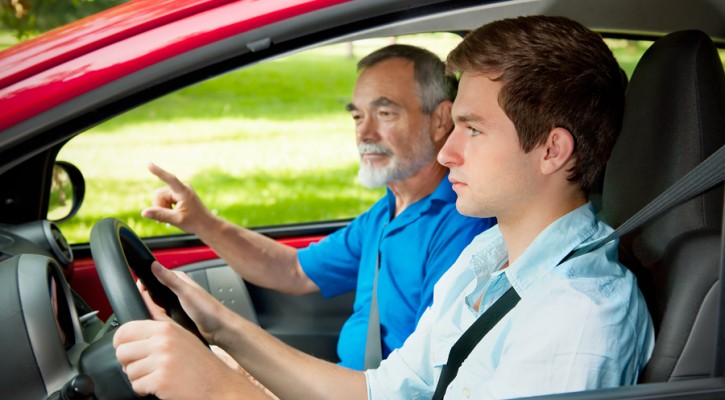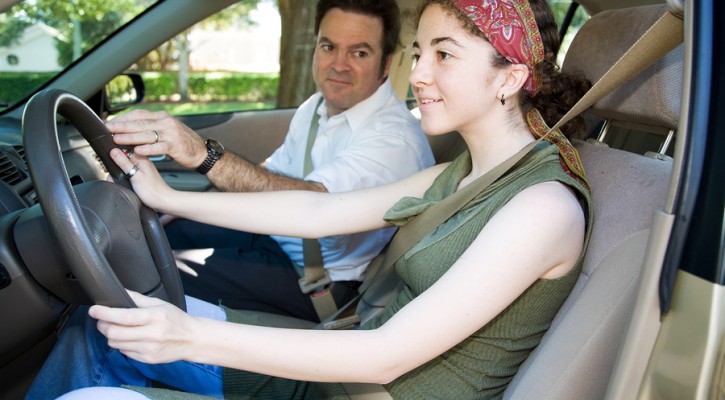Tag Archive: teen driver safety
Driver Education: How Drugs Affect Driving – Inhalants
June 17, 2009
Most parents worry that their teens will get involved in illegal drugs, but some parents are unaware of one of the main determinants of whether teens will experiment with drugs – availability. Because they are legal, easily accessible household products, inhalants are one of the most commonly abused drug categories. According to the 2007 Partnership Attitude Tracking Study, 4.6 million teens have tried inhalants. After alcohol, cigarettes, and marijuana, inhalants are the most frequently-used drug by teens. According to the Drug Enforcement Administration, inhalants are one of the first substances abused by children. Though addiction is rare, inhalants can act as a gateway drug when they are replaced with other accessible substances as children age and chase the next high.
Inhalants include solvents, such as paint thinner, gasoline, and glue; gases, such as butane, propane, and nitrous oxide; and aerosol propellants. Experimentation could occur with any household product containing chemicals – spray paint, cleaning products, felt-tip marker fluid, vegetable oil spray, correction fluid. Inhalants are “sniffed” from an open container or “huffed” from a rag soaked in the substance and held to the face. According to the National Institute on Drug Abuse, most inhalants cause a quick high similar to alcohol intoxication. The intoxication from inhalants typically only lasts a few minutes, so users often inhale repeatedly over a period of several hours, increasing the risk of adverse effects.
Effects of inhalants include:
- stimulation
- loss of inhibition
- slurred speech
- loss of motor coordination
- headache
- nausea or vomiting
- wheezing
- loss of sensation
- loss of consciousness
- muscle cramps and weakness
- memory impairment
- weight loss
- depression
- damage to the cardiovascular and nervous systems
- sudden death, even with first-time use
Because abuse of inhalants often occurs at a friend’s house or in out-of-the-way places such as in empty parking lots and on dead-end streets, and because driving is viewed as a fun activity by teens, the danger of inhalants can be compounded when teens use inhalants and drive. The intoxication caused by inhalants can cause the same problems as driving under the influence of alcohol – impaired judgment and decision-making, risky driving behavior, and poor motor coordination.
Ensuring that teens don’t experiment with inhalants requires a high degree of vigilance on the part of the parent. Inhalants are cheap, legal and easy to obtain, often from the teen’s own home. Teens are often not aware of the risk of using inhalants, reasoning that they are harmless household products and that they are only going to be used occasionally. In fact, the 2007 Partnership Attitude Tracking Study showed that from 2001 to 2005, the number of teens who perceived inhalant use as risky decreased significantly.
Parents shouldn’t assume that if they don’t mention inhalants, it won’t occur to teens to use them. At any given time, a teen can be presented with the idea by a friend. In fact, since inhalants are often the first drug used by children, they should be one of the first drug categories parents discuss. Make sure teens know that even common household goods, such as cleaning products, can be harmful – show them the warnings on the labels about using them in well-ventilated areas, and ask them to explain how they think intentionally inhaling the fumes could harm someone. Talk about the risk of sudden death from sniffing or huffing, and ask teens to talk about how they would feel if they were with a friend who died from inhalant abuse. Opportunities for reinforcing the risks of inhalant abuse are everywhere – in driver training courses, in health education classes, in newspaper articles, and on television shows.
Restricting the availability of popular substances is also important. Clean out the garage and properly dispose of leftover chemical products. Those that must be kept should be locked in a cabinet or shed. Parents may wish to help teens avoid temptation by limiting or banning aerosol spray products such as deodorants, hairspray, fabric protector, and whipped cream. Keep a close watch on teens’ bedrooms and recreational areas for empty containers or smelly rags, especially in odd places, like under a bed or chair or in the back of a closet. Parents who suspect inhalant abuse must take action immediately.

Driver Education: Traffic Safety for New High School Graduates
June 5, 2009
Summer is here and school is out. Many young drivers will be spending more time on the road going to the beach or pool, working at summer jobs, and having fun with friends. This is an especially exciting time for teens who are 2009 high school graduates. Recent grads are filled with elation, a sense of freedom, and hopes and dreams for the future. But euphoria and increased independence can cause problems when they lead relatively inexperienced drivers to take chances behind the wheel. And summertime is a dangerous time for drivers in general; traffic deaths for all drivers increase during the warm-weather months, peaking in July.
Three deadly holidays take place during the summer – Memorial Day, the Fourth of July, and Labor Day. According to the National Center for Statistics and Analysis, in a 2004 analysis of six holiday periods, the average number of traffic deaths during holiday periods was 156 per day, compared to 117 per day on non-holidays. According to the National Highway Traffic Safety Administration, 20 of the 25 deadliest days on US roads over a five-year time frame fell during the period from Memorial Day weekend to Labor Day.
Teen motor vehicle fatalities are also highest in the summer, partly because it’s an unsafe time for all drivers, but also due to risk factors specific to young drivers. Like other drivers, teens spend more time on the road during the summer (averaging 44% more hours driving each week, according to the NHTSA) and are more likely to drive at night. But they lack the experience of older drivers in dealing with heavy traffic and low-visibility conditions. Like other drivers, teens behind the wheel in the summer are often accompanied by multiple passengers. But teens are often much more distracted by their passengers than older drivers, and they are unlikely to assert themselves even when they are aware that they need to concentrate on driving.
Parents who want their teens to survive the summer must stay involved in their teens’ driving activities. Without close supervision, the vast majority of teens lack the emotional maturity to stay safe behind the wheel – or as passengers of other teen drivers.
-Though most parents will broaden driving privileges for summer, avoid giving teens too many privileges at once. Extend privileges one at a time and make sure teens prove they can handle the increased responsibility before adding more.
-Conduct supplementary driver training lessons. For example, many teens have limited experience with night driving during the school year; a few lessons will help them learn good nighttime driving habits from the beginning. A teen driving checklist helps parents provide valuable feedback on the driving lesson.
-A driver training course will help teens review fundamental driving concepts during a time when they are most at risk. A quick safe-driving refresher could help an inexperienced young driver make the right choice in an emergency. Parents whose teens receive even one traffic ticket must address the issue immediately; tickets mean teens are probably engaging in more risky driving behaviors than parents realize.
-Parents should check up on their teens’ seat belt use as often as possible. In 2006, the NHTSA reported that 58% of 16- to 20-year olds who were involved in fatal motor vehicle collisions were not wearing seat belts. The Insurance Institute for Highway Safety reports that teen seat belt use increases over time when strict parental limits are set.
-A heightened level of awareness about their teens’ access to alcohol, particularly on holidays, is critical for concerned parents. Teens may even have access to alcohol via their friends’ parents; ensure that teens understand that underage drinking is never acceptable, no matter what any other parent says or does, even for a special occasion. Create a codeword so your teen can ask to be picked up without risking the ridicule of friends.

Driver Education: Teens and Defensive Driving
May 20, 2009
Teens are often urged to “drive defensively.” This is an excellent suggestion for any driver and is of particular importance to new drivers, who have limited experience in dealing with emergency situations and who are developing driving habits they may have for the rest of their lives. But what is defensive driving, exactly?
Driving defensively means driving in such a way that you reduce the risk of a crash, which will in turn prevent injury to yourself and others. It means going beyond following the rules of the road to put safety first. For example, if another driver is supposed to yield the right-of-way to you but fails to do so, as a defensive driver you will yield the right-of-way to that driver to avoid a collision.
Defensive driving isn’t just important in emergency situations, however. Using defensive driving techniques will help you:
- manage stressful driving conditions
- avoid traffic tickets
- keep your vehicle in good mechanical condition
- keep your driver’s license
There is no doubt that driving can be stressful, especially when traffic is heavy. One element of defensive driving is to maintain an adequate following distance from the vehicle in front of you. This decreases the risk of a rear-end collision if the vehicle ahead stops suddenly. Other ways to manage stress by driving defensively include:
- driving at a speed that is appropriate for conditions (which may be lower than, but is never higher than, the posted speed limit)
- checking intersections for cross traffic when you have a green traffic light (in case another driver runs the red light or a pedestrian is in the crosswalk)
- keeping a space cushion on all sides of your vehicle so you have room to maneuver if necessary
- watching the road ahead of your vehicle and checking your mirrors every three to five seconds so you notice hazards before they become a problem
Avoiding traffic tickets is especially important to drivers who are subject to a Graduated Driver’s Licensing program; these programs often restrict advancement to the next stage of licensure unless very few or no points accrue on the teen’s license. Traffic violations also mean hefty insurance increases for young drivers, who are already paying high rates because they are in a high-risk category. But following the rules of the road only when you’re worried about getting a ticket is not sufficient; if you’re not concentrating on driving defensively, you’re likely to make mistakes due to your reduced level of alertness. These mistakes could result in a ticket or even a crash, and even a minor fender-bender can result in points on your driving record.
Part of defensive driving is making sure that your vehicle is in good mechanical condition. Don’t wait for a breakdown to get your vehicle checked out; your owner’s manual offers a schedule of suggested maintenance tasks. Tires with low air or worn tread reduce your traction and make skids more likely. Your brakes need to be in top condition at all times. Even something as simple as not having windshield wiper fluid in the reservoir can impair your visibility and increase your chances of a crash. Don’t just put gas in the car and drive; take responsibility for ensuring that your vehicle is ready for the road.
As you’ve probably learned from your driver handbook, having a driver’s license is a privilege, not a right. This means that your driver’s license can be taken away, including for some non-driving offenses.
Driving defensively is part of an overall pattern of responsible behavior that will help you keep your license and the increased level of independence that comes with it.

The Importance of a Safe Driving Attitude
May 15, 2009
One important aspect of driver training is the development of a safe driving attitude. The reason a safe driving attitude is so important is because you will make many choices as you drive, and your driving choices have consequences. There are many benefits to a safe driving attitude, including:
- limiting stress while on the road
- saving you money on tickets and increased insurance costs
- helping you keep your driver license
- reducing your chances of being in a crash
To have a safe driving attitude, you must have control of your emotions and behavior, practice defensive driving techniques, and accept responsibility for all of your driving decisions.
Emotion is a word used to identify feelings such as anger, fear and joy. If you allow them to, emotions can change the way you assess risk and make driving decisions. When strong emotions such as anger affect you, your ability to make wise decisions may be reduced, increasing your chances of making a mistake. You may be so preoccupied with your anger that you misjudge the risks involved or don’t even notice important events in a particular driving situation.
Always be aware of your state of mind. Look at yourself objectively and decide if you really have the focus and alertness you need to safely use a motor vehicle. If you have any doubt, wait. Give yourself time to calm down and concentrate on safe driving. Learn more about how to avoid a road range incident.
You can expect some emotional stress in your everyday driving. Learning to manage it is important for your safety and the safety of others:
- If you are angry and excited, take a short walk, write your feelings down or talk to a friend before you get behind the wheel.
- No matter what is going on in your life, when you get behind the wheel, make a decision that until you arrive safely at your destination, you will focus on driving.
- Always allow plenty of time to get to your destination so you won’t get impatient with red lights or heavy traffic.
- Realize that many aspects of driving, such as heavy traffic and the actions of other drivers, are beyond your control. Stay calm when faced with stressful road conditions.
Part of having a safe driving attitude is consistently practicing defensive driving techniques:
- Make sure your vehicle is properly maintained
- Wear your safety belt and make sure your passengers do the same
- Choose a speed appropriate for conditions
- Make sure you have a space cushion all around your vehicle whenever possible
- Be alert and aware of the actions of all other road users, including motorcyclists, bicyclists, and pedestrians
- Watch the road ahead, behind and on both sides of your vehicle
- Anticipate problems early and select the best course of action in case the worst happens
- Give other drivers the benefit of the doubt when they make mistakes
Accepting responsibility for our decisions is an important part of becoming an adult. Willingness to do so demonstrates maturity and trustworthiness. When you drive, you must make sure you are willing to accept responsibility for all of your driving decisions. Other drivers cannot make you behave in one way or another; your reactions to their behavior are within your control. You must discipline yourself to put safety first no matter what any other driver does.
Developing a safe driving attitude is an important component of driver training; doing so from the beginning of your driving career will help keep you and others out of harm’s way on the road.

Support for Graduated Driver Licensing Laws
April 30, 2009
According to the National Highway Safety Administration (NHTSA), adolescent drivers, especially 16- to 17-year olds, are disproportionately involved in deadly motor vehicle crashes. Sixteen-year old drivers have crash rates that are about three times greater than 17-year-old drivers, five times greater than 18-year-old drivers, and approximately twice the rate of 85-year-old drivers. According to the NHTSA and the Insurance Institute for Highway Safety (IIHS), specific contributors to these higher crash rates include:
- Lack of driving experience and skills: Compared with crashes of older drivers, those of 16-year-olds more often involve driver error.
- A propensity towards risk taking behavior and poor decision-making.
- Driving at night: Per mile driven, the nighttime fatal crash rate for 16-year-old drivers is twice as high as during daytime hours.
- Distraction from teenage passengers: Fatal crashes involving 16-year-old drivers are more likely to take place when other teens are in the vehicle, and the risk increases with every additional passenger.
- Speeding: Sixteen-year old drivers have a higher rate of crashes in which excessive speed is a contributing factor.
Graduated Driver Licensing (GDL) programs help young drivers get driving experience progressively while minimizing risk, beginning with a restricted permit and eventually leading to full licensure.
Most programs include three stages:
- Learner Stage: Supervised driving, ending with a road test.
- Intermediate Stage: Limiting unsupervised driving in high-risk circumstances.
- Full Privilege Stage: A regular driver’s license.
Provisions of graduated licensing laws may include:
- Required hours of adult supervision during the learner stage.
- Restrictions on late-night driving.
- Restrictions on driving with teen passengers.
- Seat belt requirements for drivers and passengers.
- Restrictions on cellular phone use.
- Prohibiting the driver from moving up to the next level due to traffic violations.
GDL laws in most of the states that have them do not comply with all of the recommendations of the NHTSA; still, there has been an overall decrease in fatal crashes nationally since GDL laws began to be implemented. In 2006, 7,463 drivers who were 15 to 20 years old were involved in fatal crashes – an eight percent decrease from 8,074 involved in 1996. Individually, states with GDL laws also show improvement:
- California: A five percent decrease in crashes for 16- and 17-year-old drivers.
- Florida: A nine percent decrease in crashes for 16- and 17-year old drivers.
- Michigan: A 26% decrease in crashes for 16-year-old drivers.
- North Carolina: A 25% decrease in crashes for 16-year-old drivers.
- Oregon: A 29% decrease in crashes for 16-year-old drivers and a 16% decrease in crashes for 17-year-old drivers.
NHTSA research has also found that the most comprehensive GDL programs are associated with the greatest decrease in crash rates for teen drivers.
It is more difficult to evaluate the individual components of GDL laws because of the overlap of restrictions, but the NHTSA has conducted some research in this area. An analysis of the passenger restriction laws in California, Massachusetts, and Virginia indicated that there were 740, 173, and 454 fewer 16-year-old involved in crashes per year, respectively. A different study found that states with nighttime driving restrictions for teen drivers show decreases in crashes of up to 60% during the restricted hours.
Public support for GDL laws is also strong. In 2007, the NHTSA conducted the Motor Vehicle Occupant Safety Survey (MVOSS), a national telephone survey about driver safety. Seventy-nine percent of the participants said that teen drivers should proceed from a learner’s permit to a provisional license status rather than directly to an unrestricted adult license. The results of the survey also indicated strong support, ranging from 73% to 99%, for specific restrictions on provisional driver license status, such as:
- Requiring young drivers to wear a seat belt at all times.
- Prohibiting driving after 9pm, unless supervised by an adult.
- Limiting the number of teenage passengers allowed in the vehicle.
- Prohibiting the use of a cellular phone while driving.
- Requiring the new driver to hold the provisional license for at least one year without any traffic violations before receiving an unrestricted adult license.
GDL provisions are still in their infancy in many states, so evaluating the results of these programs is difficult. However, outcomes so far are promising. The enactment of and enforcement of these laws are important steps in efforts to save the lives of young drivers.
